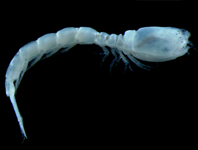Abstract
A taxonomic and phylogenetic study of Sphecidae based on morphology of last instar larvae and eggs is presented, including description of the family and a key to identify genera, tribes and subfamilies. Larval morphology of 12 species of Sphecidae was studied, along with four others used as outgroups (belonging to Ampulicidae, Crabronidae and Apidae). Thirty characters were listed from the morphological studies. Four genera were included in the analysis based only on literature. Thus, representatives of all the subfamilies and tribes of the Sphecidae were included in the analysis, except those of Stangeellini. The characters matrix was submitted to a parsimonious analysis using TNT version 1.5 and generated four equally parsimonious trees, with Length = 46, Consistence Index = 0.739, Retention Index = 0.878. The hypothesis of relationship suggested by the larvae and eggs is congruent with those suggested by the adult morphology in previous studies. The taxa Sphecidae, Sceliphrinae, Podiini, Sceliphrini, Prionychini and Ammophilinae, as well the assemblages Sceliphrinae + Chloriontinae and Sphecinae + Ammophilinae were supported by larval apomorphies. No apomorphy supporting the monophyly of Sphecinae and Sphecini was found.
References
Alexander, A.B. (1992) An exploratory analisis of cladistic relationship within the superfamily Apoideae, with special reference to sphecid wasps (Hymenoptera). Journal of Hymenoptera Research, 1 (1), 25–61.
Asís, J.D., Gayubo, S.F. & Tormos J. (1997) Description of the mature larvae of several species of Psenulus, with comments on larval characters in the genus (Hymenoptera Sphecidae). Annales de la Société Entomologique de France, New Series, 33, 197–203.
Bohart, R.M. & Menke, A.S. (1963) A reclassification of the Sphecinae, with a revision of the Neartic species of the tribes Sceliphronini and Sphecini (Hymenoptera, Sphecidae). University of California Publications in Entomology, 30, 91–182.
Bohart, R.M. & Menke, A.S. (1976) Sphecidae wasps of the world: a generic revision. University of California Press, Berkeley, California, 695 pp.
Buys, S.C. (2001) Last instar larva of Penepodium dubium (Hymenoptera: Sphecidae). Revista de Biología Tropical, 49 (1), 329–332.
Buys, S.C. (2007) Morphological studies on the last instar larva of Ampulex compressa (Fabricius) from Brazil (Insecta, Hymenoptera, Ampulicidae). Spixiana, 30, 33–37.
Buys, S.C. (2011) Morphology of the last instar larvae of Prionyx thomae (Fabricius, 1775) and P. fervens (Linnaeus, 1758) (Hymenoptera, Sphecidae). Spixiana, 34 (2), 225–230.
Buys, S.C. (2014) Morphology of the last instar larvae of Sceliphron asiaticum (Linnaeus, 1758) and S. fistularium (Dahlbom, 1843), with a review of larval characters in Sceliphrinae (Hymenoptera: Sphecidae). Journal of Natural History, 48, 375–386.
https://doi.org/10.1080/00222933.2013.802385
Evans, H.E. (1959) Studies on the larvae of digger wasps (Hymenoptera, Sphecidae). Part V. Conclusion. Transactions of the American Entomological Society, 85, 137–191, pls. XVIII–XXIV.
Evans, H.E. (1964a) Further studies on the larvae of digger wasps (Hymenoptera: Sphecidae). Transactions of the American Entomological Society, 90, 235–299, pls. VIII–XIX.
Evans, H.E. (1964b) The classification and evolution of digger wasp as suggested by larval characters. Entomological News, 75, 225–237.
Evans, H.E. & Lin, C.S. (1956) Studies on the larvae of digger wasps (Hymenoptera, Sphecidae) Part I: Sphecinae. Transactions of the American Entomological Society, 81, 131–153, pls. I–VIII.
Field, J., Ohl, M. & Kennedy, M. (2011) A molecular phylogeny for digger wasps in the tribe Ammophilini (Hymenoptera, Apoidea, Sphecidae). Systematic Entomology, 36, 732–740.
https://doi.org/10.1111/j.1365-3113.2011.00591.x
Genise, J.F. (1982) Descipciones de larves de Bembicini (Hym., Sphecidae). Comunicaciones del Museo Argentino de Ciências Naturales “Bernardino Rivadavia” e Instituto Nacional de Investigación de las Ciências Naturales, Entomologia, 1 (8), 113–123.
Goloboff, P., Farris, J., Källersjö, M., Oxelman, B. & Ramírez, M.J. (2003) Improvements to resampling measures of group support. Cladistics, 19, 324–332.
https://doi.org/10.1111/j.1096-0031.2003.tb00376.x
Goloboff, P.A. & Catalano, S.A. (2016) TNT version 1.5, including a full implementation of phylogenetic morphometrics. Cladistics, 32, 221–238.
https://doi.org/10.1111/cla.12160
Grandi, G. (1961) Studi di un Entomologo sugli Imenotteri superiori. Bollettino dell’Istituto di Entomologia della Università di Bologna, 25, i–xv + 1–659.
Hansen, R.V. (1987) Revision of the subgenus Prosceliphron van der Vecht (Hymenoptera, Sphecidae). Tijdschrift voor Entomologie, 129 (8), 217–261.
Iida, T. (1967) A study on the larvae of the genus Sphex in Japan (Hymenoptera: Sphecidae). Etizenia, 19, 1–8.
Lomholdt, O. (1982) On the origin of the bees (Hymenoptera: Apidae, Sphecidae). Entomologica Scandinavia, 13, 185–190.
https://doi.org/10.1163/187631282X00093
Melo, G.A.R. (1999) Phylogenetic relationship and classification of the major lineage of Apoidea (Hymenoptera), with emphasis on crabronid wasps. Scientific papers. Natural History Museum, The University of Kansas, 14, 1–55.
https://doi.org/10.5962/bhl.title.4053
Menke, A.S. (1961) A review of the Nearctic species of Chlorion (Hymenoptera: Sphecidae), with description of a new species of Baja California. Annals of the Entomological Society of America, 54, 667–669.
https://doi.org/10.1093/aesa/54.5.667
Menke, A.S. (1966) The genera of Ammophilini (Hymenoptera: Sphecidae). Canadian Entomologist, 98, 147–152.
https://doi.org/10.4039/Ent98147-2
Ohl, M. (1996a) Die phylogenetische Beziehungen der Sphecinae (Hymenoptera: Apoidea: “Sphecidae”) aufgrund morphologischer Merkmale des Exoskeletts. Zoologische Beiträge, Neue Folge, 37, 3–40.
Ohl. M. (1996b) The phylogenetic relationships within the Neotropical Podiinae with special reference to Podium Fabricius (Hymenoptera: Apoidea: “Sphecidae”). Deutsche Entomologische Zeitschrift, 43, 189–218.
https://doi.org/10.1002/mmnd.4800430204
Pulawski W.J. (2020a) Catalog of Sphecidae sensu lato (= Apoidea excluding Apidae). Number of species. Available from: http://researcharchive.calacademy.org/research/entomology/entomology_resources/hymenoptera/sphecidae/number _ of _ species.pdf (accessed 16 August 2020)
Pulawski, W.J. (2020b) Catalog of Sphecidae sensu lato (= Apoidea excluding Apidae). Family groups and names. Available from: http://researcharchive.calacademy.org/research/entomology/entomology_resources/hymenoptera/sphecidae/family_group_names_and_classification.pdf (accessed 16 August 2020)
van der Vecht, J. & van Bruegel, F.M.A. (1968) Revision of the nominate subgenus Sceliphron Latreille (Hym., Sphecidae) (Studies on the Sceliphronini, part 1.). Tijdschrift voor Entomologie, 3, 185–225.
Vardy. C.R. (1978) A revision of the Neotropical wasp genus Trigonopsis Perty (Hymenoptera: Sphecidae). Bulletin of the British Museum of Natural History, Entomology Series, 37 (4), 117–152.


